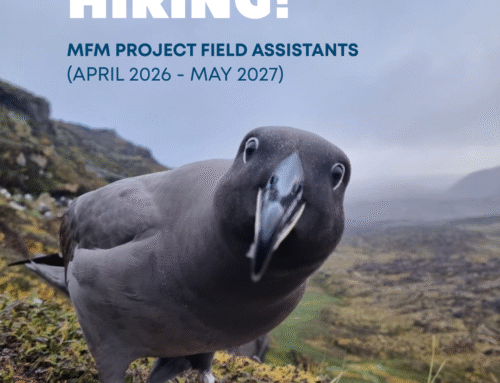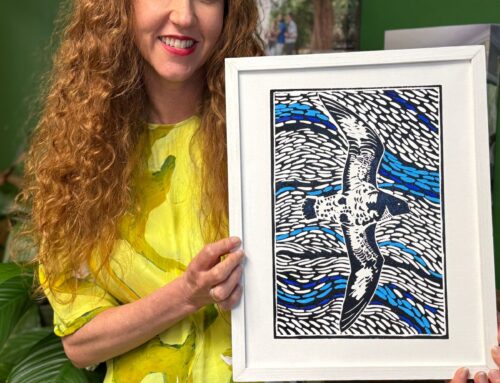Above Picture: Steve and Pat Pringle on South Georgia in 2015, with a passing Black-browed Albatross
UK-based, but University of Cape Town-educated, Stephen and Patricia Pringle have sponsored 25 hectares towards eradicating Marion Island’s House Mice in 2024, thus joining only eight others in the prestigious “Grey Petrel Club”. Steve writes to MFM News on their generous donation:
“We haven’t been to Marion Island, but we have met many ecologists and ornithologists who have been there and to other Southern Ocean islands over the years, going back to the late 1960s. However, we do have a very strong personal connection with the island – Pat and I would never have met but for an introduction through marine ornithologist Tony Williams, who took a ship from the UK to Cape Town in 1973 on his way to work on Marion Island’s seabirds.”
“We have both had a life-long interest in wildlife, and we have supported financially many conservation projects over the years, mostly in African countries. We have also been very fortunate to have visited numerous remote and beautiful islands, including South Georgia in the South Atlantic. Our visit there in 2015 was early in that island’s pest eradication project. We were very impressed with the ultimately successful effort to eradicate rats and mice and so added our small contribution to the project. The results have been stunning. What is most satisfying is the speed with which positive results have been achieved. A project such as on South Georgia had a fairly exact budget and timescale, and the bird populations then recovered rapidly, whereas many conservation projects are well-meaning, take a lot of effort and resources, but achieve very little. What makes the MFM Project so exciting is that, although a bit different, it has a very clear-cut goal and promises to be another South Georgia-type success story for conservation.”
“A couple of years ago we visited some of the small islands around New Zealand where introduced predators had been eradicated – again the results in terms of endemic bird population recovery are fairly rapid but maintaining the pest-free status of islands close to the mainland coast requires constant and costly efforts. Hopefully, this won’t be a problem at Marion as it is so remote and there are excellent biosecurity controls in place.”
“A lifetime ago, we both lived in Cape Town and were very involved in birding/research activities, before returning to England in the mid-1970s. After our careers in science, engineering and technology I returned in retirement to academia in the field of Conservation Biology in an honorary capacity and am now a visiting research fellow in the School of Environment at the University of Leeds where I am involved with an eight-year study of the impact of land-use change on birds in Zimbabwe.”
Steve has also kept his connection with the continent as a Life Member of the African Bird Club, for which he has served as a trustee, treasurer and admin secretary at various times.
On a personal note, Steve and I wrote some of our first scientific papers together based on shorebird counts we undertook in South Africa’s Western Cape in the 1970s, near half a century ago. All these years later it is pleasing to see that our passion for visiting seabird islands has come together in support of the Mouse-Free Marion Project.
John Cooper, News Correspondent and Member, Scientific & Technical Advisory Group, Mouse-Free Marion Project, 11 January 2022











